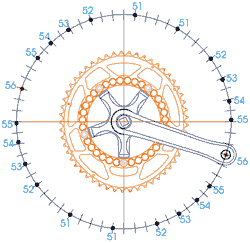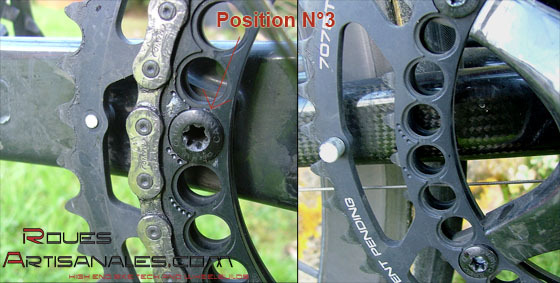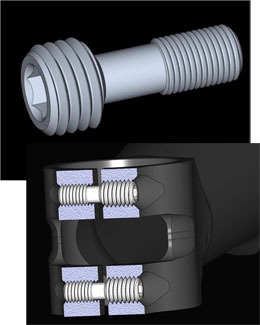|

The spanish
brand showed a lot of innovation in a classicism sector. Born from an aeronautic engineering school from Madrid, Rotor swaps the standards
fixed since years, each time they release a new product. The double thread bolts were a genious idea, it was one year ago (see here). The bottom bracket whose bearings self align to work in
perfect conditions of parallelism (drawing at the bottom of the page) definitely add to their ingeniosity. Although these breakthrough won’t change the world, this is good to see so much
innovative components from an unknown company two years ago.
About the famous non circular chainrings, the idea doesn’t come from them but Rotor have the advantage to offer a custom position of the egg-shaped chainring!
The Q-Rings, optimizing mechanics?
Let’s speak about these egg-shaped chainrings. Why does an oval chainring would be more efficient than a standard round one? After all, we still have to push the pedals, a friend concerned
about keeping the traditions, would retort.
The dead spot
While pedaling, the output power provided by the riders’ legs is not constant. The spinning motion of the crank arms changes the lever arm (and so the torque) with which the rider pushes to
advance. Thus, the lever arm is the best when the crank arm is perfectly horizontal (or close to it, it depends on the morphology of the rider), because the energy provided is entirely
transfered through the cranks to the chain, etc. Contrary to this position, when the crank arm is vertical, the lever arm is equivalent to zero and so it is not possible to transfer power.
The crank arm fortunately doesn’t remain in this position: it continues its motion thanks to the inertia created by the rider’s legs, its shoes, the cranks and the pedals.
Finally, the chainring itself also have a lever arm proportionnal to its diameter, and so to its number of teeth. The biggest it is, the most torque it transfers to the chain. The torque
(in N.m or lbs.in) depends on the lever arm (length) multiplying the strength the rider produces (in N).
Lever arm variation

From this observation, the manufacturers developed oval chainrings; they have the advantage to provide different chainrings diameters and so different lever arms. Thus, when the crank arm
is horizontal, the torque is maximal, so one have to place the big diameter of the chainring perpendicular to the crank arm to make the lever arm as big as possible. On the other side, when
the crank arm is close to the vertical position, the dead spot has to be lowered, meaning higher rotation speeds, so the the lever arm has to be reduced: smaller chainring diameter.
At Rotor, the position of the chainring is custom so you can sharpen it according to your feelings. The position 3 is intermediary, the larger diameter is perpendicular (or a little lower)
to the crank arm.
Thus, a 53 Rotor chainring corresponds to a 56 teeth chainring when the crank arm is horizontal, or a 51 in vertical position. See the drawing on the right.
It’s possible to position the chainring to have a lot of different positions, but you can benefit from « only 5″ of them ». Some small marks indicates how you have to place the ring.
According to the feelings, it is of course possible to differenciate the two rings.

Functionning
Mounting the chainrings is quite easy. In our case, for a Campagnolo crank arm, we had to place the mark corresponding to the position, juste behind the crank arm (i.e picture above).
However the front derailleur setting was not as easy.
First, since we were on a 53 round chainring and went to a 53 Q-Ring whose diameter is equivalent to a 56 teeth round chainring, at least in the high position, we had to raise the
derailleur position. If the cable were at the right length for the original position, it will be get too short… so expect a new one.
Second, still because of the diameter difference between the high and low position of the chainring, the chain tends to rub the inner plate of the front derailleur when crossing the chain a
little too much (53×19 on a 11-23 cassette). The setting has to be very fine if you don’t want the chain to drop on the small chainring! Beware during races…
A system for anyone?
Placebo effect or not, we realized after a thousand kilometers that we still feel like always pushing a too (too?) big gear. Perhaps a proof that the system is efficient and
indeed behave as a 56 teeth. During the biggest intensities, it « burns » more: the resting phases, created by the dead spot, seem shortened. With the time, it gets a habit.
About the reduction of the dead spot, the phenomenon is hardly perceptible as long as the pedaling frequency is normal, let’s say between 80 and 110 rounds per minute, the inertia
we generate when spinning the legs helps to pass it easily. Under 80 rpm, we feel like it is easier to pedal regularly.
|
|
This feeling is very personnal and it will probably be different for someone else whose morphology and pedaling style is different.
In short, this system comes with feelings different from the standard round rings, and it feels better than them after hundreds kilometers. One can wonder if the system comes too with a
performance rise? From a rider point of view, it’s not possible to claim anything since there are too many factors playing a role in the performance.
However, the site RotorCranks in the USA gives some useful insights:
– 3% more max power
– 2% lower hearth rate
– 9% less lactic acid concentration
These figures mean a lot and would, according to the manufacturer, optimize the performance while reducing the hearth rate, so the energy spent, and while increasing the maximal power.
Unfortunately the figures can hardly be controlled, and have to be taken with a pinch of salt since they come from the manufacturer itself. Beside this, some scientific studies prove an
absence of difference between round and Q-Rings.
So the system definitely sounds promising, it improves the mechanics and changes the pedaling style. But from a performance point of view, the debate still is opened.

An innovating range
The range indeed is full of innovations we hope they will follow this straight line, not leaded by the marketing, but by genious ideas:
|
The bottom bracket whose bearings « self-align ». A lot of frames, even top range frames, do not have perfectly aligned threads.
|
The dual thread bolt: when a half of the bolt advance of X millimeters, the other half advance of a different distance and allow the tightening.
|

|

|
|






